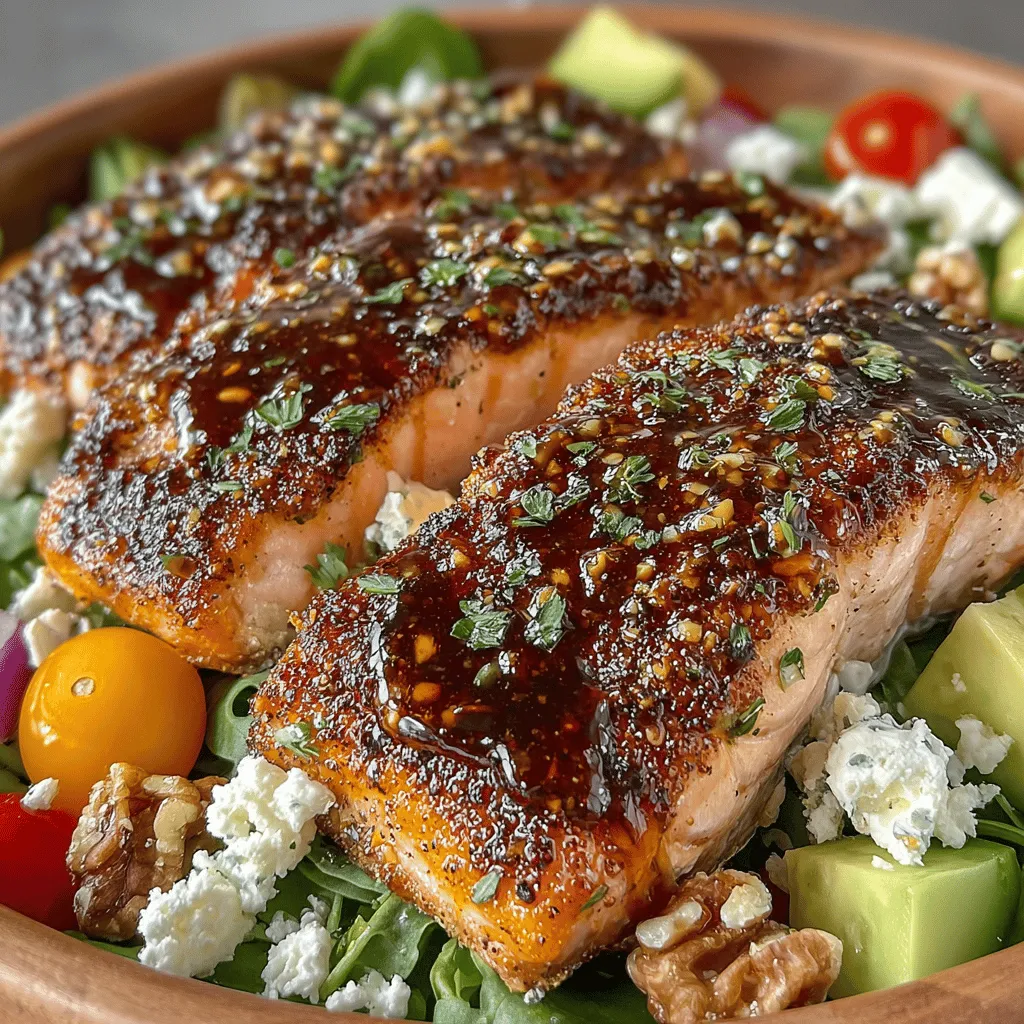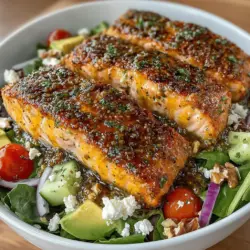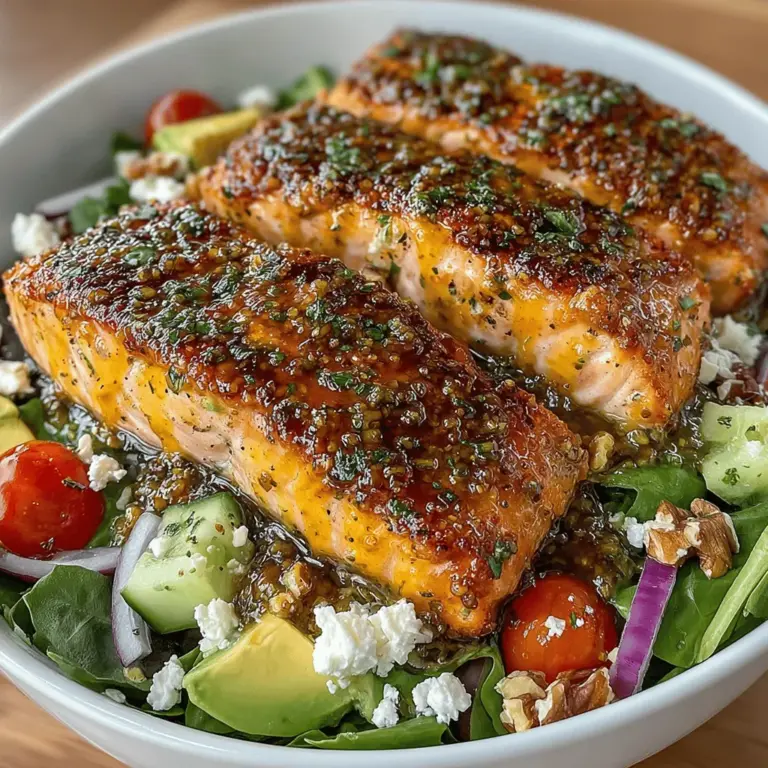This Honey Mustard Glazed Salmon Salad is a delightful fusion of flavors that brings together tender, flaky salmon coated in a sweet and tangy glaze, served atop a bed of fresh, vibrant greens. The dish not only tantalizes the taste buds but also packs a nutritious punch thanks to its wholesome ingredients. Rich in omega-3 fatty acids and essential vitamins, salmon is a superfood that supports heart health and overall well-being. This salad is perfect for a light lunch or dinner, catering to various dietary preferences and making it a versatile option for any occasion.
Ingredients
– 2 salmon fillets
– 2 tablespoons honey
– 1 tablespoon Dijon mustard
– Salt and pepper, to taste
– 4 cups mixed salad greens (spinach, arugula, or romaine)
– 1 cup cherry tomatoes, halved
– 1 cucumber, sliced
– 1/4 red onion, thinly sliced
– 1 avocado, diced
– 1/4 cup nuts (walnuts or almonds), chopped
– Optional: 1/4 cup feta cheese, crumbled
Instructions
1. Preheat the oven to 400°F (200°C).
2. In a small bowl, whisk together honey and Dijon mustard until well combined.
3. Season the salmon fillets with salt and pepper, then place them on a lined baking sheet.
4. Brush the honey mustard glaze generously over the top of each salmon fillet.
5. Bake in the preheated oven for 12-15 minutes, or until the salmon flakes easily with a fork.
6. While the salmon is baking, prepare the salad by combining mixed greens, cherry tomatoes, cucumber, red onion, avocado, and nuts in a large bowl.
7. Once the salmon is cooked, remove it from the oven and let it rest for a few minutes before flaking it into large pieces.
8. Divide the salad among plates and top with the flaked salmon and optional feta cheese.
9. Drizzle any remaining honey mustard glaze over the assembled salad before serving.
The Nutritional Benefits of Salmon
Salmon is often celebrated as a superfood, and for good reason. It is rich in omega-3 fatty acids, which are crucial for heart health and brain function. These healthy fats help reduce inflammation and lower the risk of chronic diseases. Additionally, salmon is an excellent source of high-quality protein, providing essential amino acids that support muscle repair and growth. Including fish like salmon in your diet can contribute significantly to a balanced, nutrient-dense eating plan.
Ingredients Breakdown
The key ingredients in this Honey Mustard Glazed Salmon Salad each play a vital role in both flavor and nutrition.
– Salmon Fillets: Choosing fresh, high-quality salmon is essential for the best flavor and texture. Look for fillets that are firm, moist, and have a vibrant color.
– Honey and Dijon Mustard: This glaze combines sweetness from honey with the tangy kick of Dijon mustard, creating a balanced flavor profile that enhances the salmon.
– Fresh Vegetables: The salad is packed with greens, tomatoes, cucumbers, and onions, all of which provide fiber, vitamins, and minerals that are crucial for overall health.
– Avocado and Nuts: These ingredients add healthy fats, which are beneficial for heart health and help keep you satiated.
– Optional Feta Cheese: While not necessary, feta cheese can add a creamy texture and salty flavor that complements the dish well. Consider dietary preferences when including this ingredient.
Preparing the Honey Mustard Glaze
To create the perfect honey mustard glaze, start by combining honey and Dijon mustard in a bowl. The key to a great glaze is balancing the sweet and tangy flavors. Adjust the ratio of honey to mustard according to your taste preference. If you like it sweeter, add more honey; for a sharper taste, increase the mustard. The glaze should have a smooth consistency—if it’s too thick, you can thin it out with a little olive oil or water. For those looking to mix things up, consider adding a splash of lemon juice for brightness or a pinch of garlic powder for an extra depth of flavor.
Cooking the Salmon to Perfection
Getting the cooking temperature and time just right is crucial when preparing salmon. Preheating your oven to 400°F (200°C) ensures that the salmon cooks evenly and remains moist. The general rule of thumb is to bake salmon for about 12-15 minutes, depending on the thickness of the fillets. To determine doneness, look for visual cues such as the salmon turning opaque and flaking easily with a fork. The internal temperature should reach about 145°F (63°C) for safe consumption. Remember, overcooking can lead to dry salmon, so keep a close eye on it as it bakes.

Tips for Avoiding Common Mistakes When Baking Salmon
When baking salmon, it’s essential to avoid several common pitfalls to achieve perfect results. Here are some tips to ensure your salmon turns out moist and flavorful:
Ensure Even Cooking
To achieve even cooking, try to select fillets that are similar in thickness. If your salmon is uneven, consider pounding the thicker sections gently to even them out. This helps to ensure that the entire piece cooks uniformly.
Don’t Overcook
Salmon can dry out quickly if overcooked. To avoid this, use a meat thermometer to check for doneness. The internal temperature should reach 145°F. Removing it from the oven when it’s slightly undercooked (around 140°F) allows it to continue cooking from residual heat.
Use the Right Baking Dish
Choose a non-stick baking dish or line your baking sheet with parchment paper. This not only prevents sticking but also makes cleanup easier.
Alternative Cooking Methods
While baking is a popular method for cooking salmon, grilling or pan-searing can provide different flavor profiles that enhance your dish.
Grilling
Grilling salmon imparts a smoky flavor that complements the honey mustard glaze beautifully. Preheat your grill and lightly oil the grate to prevent sticking. Grill for about 4 to 6 minutes per side, depending on thickness.
Pan-Searing
Pan-searing offers a crispy exterior while keeping the inside tender. Heat a small amount of oil in a skillet over medium-high heat. Cook the salmon skin-side down first for about 4 minutes, then flip and cook for another 3-4 minutes until done.
Creating the Perfect Salad Base
Importance of Fresh Ingredients
Fresh ingredients are crucial for the best flavor and texture in your salad. When selecting greens and vegetables, look for vibrant colors, crisp textures, and no signs of wilting.
Selecting and Storing Salad Greens
Choose salad greens like spinach, arugula, or mixed baby greens. Store them in a breathable bag in the refrigerator to maintain freshness. Avoid washing them until just before use to prevent sogginess.
Slicing Vegetables
When slicing vegetables, aim for uniformity in thickness to ensure even texture. For instance, julienne carrots and slice bell peppers thinly to add crunch and flavor without overpowering the dish.
Role of Each Salad Component
Each component of your salad should complement the salmon. For instance, nuts add crunch, while fruits like apples or berries introduce sweetness that balances the glaze. Consider adding cheese for creaminess, enhancing both flavor and texture.
Crafting the Dressing
Step-by-Step Instructions
To make the dressing, whisk together equal parts honey and Dijon mustard, then slowly drizzle in olive oil while whisking to create an emulsion. Adjust seasoning with salt and pepper to taste.
Emulsifying Ingredients
The key to a creamy dressing lies in emulsifying ingredients like mustard or egg yolk. These help to combine oil and vinegar, resulting in a smooth texture that clings beautifully to the salad ingredients.
Variations for Different Profiles
For a twist on the classic dressing, consider adding fresh herbs like dill or basil for a herby flavor. You can also incorporate spices like paprika or cayenne for a hint of heat.
Assembling the Salad
Layering Ingredients
When assembling your salad, start with the greens as a base, then layer on the vegetables, nuts, and salmon. This method not only enhances visual appeal but also ensures a balanced bite every time.
Tossing Gently
To maintain the integrity of the ingredients, toss the salad gently. Use your hands or two large utensils to mix everything without bruising the greens or breaking the salmon.
Presentation Suggestions
Consider using a large platter for serving, arranging the salmon on top of the salad for a beautiful presentation. Garnish with fresh herbs or a sprinkle of seeds to add color and texture.
Serving Suggestions and Pairings
Side Dishes
Pair your honey mustard glazed salmon salad with light sides like roasted asparagus or quinoa for a complete meal. These sides complement the flavors of the salad without overshadowing them.
Beverage Pairings
For beverages, a crisp white wine like Sauvignon Blanc or a refreshing iced tea works well. These drinks enhance the dish’s freshness and balance the richness of the salmon.
Versatility of the Salad
This salad can be served both as a main dish or a side, making it versatile for any occasion. It’s perfect for a light lunch or as part of a larger dinner spread.
Conclusion
The honey mustard glazed salmon salad combines healthiness with rich flavors, making it an appealing choice for any meal. Its ease of preparation makes it suitable for busy lifestyles, while the opportunity to experiment with ingredients encourages creativity in the kitchen. Enjoy the process of cooking and have fun discovering new flavor combinations that suit your taste!


